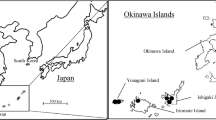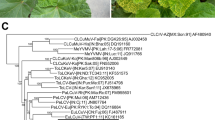Abstract
Petunia plants are used for urban landscaping in many parts of the world, including South Korea. In this study, we aimed to investigate the occurrence of petunia vein clearing virus (PVCV) infection in petunia plants in Seoul, South Korea. PVCV was detected from 23 of 79 petunia samples collected from Seoul. We obtained the complete genome sequences of the Korean isolates in this study (called PVCV-Kr, Kr2, and Kr3), which were compared with the genome sequence of the USA isolate of the virus (PVCV-USA). The genomic DNA of the three PVCV isolates was found to comprise 7210–7267 nucleotides (nts), which is 4–15 nts longer than the PVCV-USA genome. The genomes of the Kr and Kr2 isolates encode a large polyprotein of 252 kDa (2180 amino acids (aa)). The genome of the Kr3 isolate encodes a large polyprotein of 255 kDa (2203 aa). The polyprotein has six protein domains: a movement protein (MP; 72 aa), a coiled-coil domain (CC; 33 aa), an RNA-binding domain (RB; 18 aa), a protease (PR; 21 aa), a reverse transcriptase (RT; 196 aa), and an RNase H (RH; 121 aa). The large polyprotein and six domains of the three isolates showed 93.9–100.0% sequence homology with those of PVCV-USA. Furthermore, the polymerase polyprotein gene (PR, RT, and RH) of the four PVCV isolates containing the USA isolate grouped with those of Rice tungro bacilliform virus and Soybean chlorotic mottle virus, which belong to the same family (Caulimoviridae). Our findings suggested that the Korean isolates represent a new isolate of PVCV. To our knowledge, this is the first report of PVCV detection in South Korea.






Similar content being viewed by others
References
Lesemann D, Casper R (1973) Electron microscopy of petunia vein-clearing virus, an isometric plant virus associated with specific inclusions in petunia cells. Phytopathology 63:1118–1124
Lockhart BEL, Lesemann D (1998) Occurrence of petunia vein-clearing virus in U.S.A. Plant Dis 82:262
Harper G, Richert-Poggeler KR, Hohn T, Hull R (2003) Detection of petunia vein-clearing virus: model for the detection of DNA viruses in plants with homologous endogenous pararetrovirus sequences. J Virol Methods 107:177–184
Gera A, Sikron N, Cohen J, Zeidan M (2007) First report of Petunia vein clearing virus in Israel. Plant Dis 84:201
Staginnus C, Richert-Pöggeler KR (2006) Endogenous pararetroviruses: two-faced travelers in the plant genome. Trends Plant Sci 11:485–491
Diop SI, Geering ADW, Alfama-Depauw F, Loaec M, Teycheney P, Maumus F (2018) Tracheophyte genomes keep track of the deep evolution of the Caulimoviridae. Sci Rep 8:572
Richert-Pöggeler KR, Minarovits J (2014) Chapter 14—Diversity of latent plant–virus interactions and their impact on the virosphere. In: Gaur RK, Hohn T, Sharma P (eds) Plant virus–host interaction. Academic Press, London/NewYork, pp 263–275
Richert-Pöggeler KR, Noreen F, Schwarzacher T, Harper G, Hohn T (2003) Induction of infectious petunia vein clearing (pararetro) virus from endogenous provirus in petunia. EMBO J. 22:4836–4845
Richert-Pöggeler KR, Shepherd RJ (1997) Petunia vein-clearing: a plant pararetrovirus with the core sequences for an integrase function. Virology 236:137–146
Noreen F, Akbergenov R, Hohn T, Richert-Poggeler KR (2007) Distinct expression of endogenous Petunia vein clearing virus and the DNA transposon dTph1 in two Petunia hybrida lines is correlated with differences in histone modification and siRNA production. Plant J 50:219–229
Gawel NJ, Jarret RL (1991) A modified CTAB DNA extraction procedure for Musa and Ipomoea. Plant Mol Biol Rep 9:262–266
Kwon JY, Kwon JY, Hong JS, Kim MJ, Choi SH, Min BE, Song EG, Kim HH, Ryu KH (2014) Simultaneous multiplex PCR detection of seven cucurbit-infecting viruses. J Virol Methods 206:133–139
Mallona I, Lischewski S, Weiss J, Hause B, Egea-Cortines M (2010) Validation of reference genes for quantitiative real-time PCR during leaf and flower development in Petunia hybrid. BMC Plant Biol 10:4
Stavolone L, Villani ME, Leclerc D, Hohn T (2005) A coiled-coil interaction mediates cauliflower mosaic virus cell-to-cell movement. Proc Natl Acad Sci USA 102:6219–6224
Smith BR, Fisher PR (2004) Growth and pigment content of container-grown impatiens and petunia in relation to root substrate pH and applied micronutrient concentration. HortScience 39:1421–1425
Sramek F, Dubsky M (2011) Occurrence and correction of lime-induced chlorosis in petunia plants. Plant Soil Environ 57:180–185
Gayral P, Blondin L, Guidolin O, Carreel F, Hippolyte I, Perrier X, Iskra-Caruana M (2010) Evolution of endogenous sequences of Banana streak virus: what can we learn from banana (Musa sp.) evolution? J Gen Virol 84:7346–7359
Yasaka R, Nguyen HD, Ho SYW, Duchene S, Korkmaz S, Katis N, Takahashi H, Gibbs AJ, Ohshima K (2014) The temporal evolution and global spread of Cauliflower mosaic virus, a plant pararetrovirus. PLoS ONE 9:e85641
Bousalem M, Douzery EJP, Seal SE (2008) Taxonomy, molecular phylogeny and evolution of plant reverse transcribing viruses (family Caulimoviridae) inferred from full-length genome and reverse transcriptase sequences. Arch Virol 153:1085–1102
Geering ADW, Hull R (2011) Virus taxonomy (Family Caulimoviridae). In: King AMQ, Adams M, Carstens EB, Lefkowitz EJ (eds) Ninth report of the International Committee on taxonomy of viruses. Elsevier Academic Press, San Diego, pp 429–443
Hasegawa A, Verver J, Shimada A, Saito M, Goldbach R, Van Kammen A, Miki K, Kameya-Iwaki M, Hibi T (1989) The complete sequence of soybean chlrotic mottle virus DNA and the identification of a novel promoter. Nucleic Acids Res 17:9993–10013
Medberry SL, Lockhart BEL, Olszewski NE (1990) Properties of Commelina yellow mottle virus’s complete DNA sequence, genomic discontinuities and transcripts suggest that it is a pararetrovirus. Nucleic Acids Res 18:5505–5513
Calvert LA, Ospina MD, Shepherd RJ (1995) Characterization of cassava vein mosaic virus: a distinct plant pararetrovirus. J Gen Virol 76:1271–1276
Lockhart BE, Menke J, Dahal G, Olszewski NE (2000) Characterization and genomic analysis of tobacco vein clearing virus, a plant pararetrovirus that is transmitted vertically and related to sequences integrated in the host genome. J Gen Virol 81:1579–1585
Acknowledgements
This study was supported by Grants (2014M3A9B8022821, 2018R1D1A1B07045964, and 2019R1C1C1006312) from the National Research Foundation in Korea.
Funding
This study was funded by Grants (2014M3A9B8022821, 2018R1D1A1B07045964, and 2019R1C1C1006312) from the National Research Foundation in Korea.
Author information
Authors and Affiliations
Contributions
EGS and KHR conceived and designed the study. YEK and EGS collected the samples. YEK carried out the experiments. EGS and KHR performed the data analysis. EGS and KHR drafted the manuscript. YEK and EGS contributed equally to this study and should be considered co-first authors. SHC participated in editing the manuscript.
Corresponding author
Ethics declarations
Conflict of interest
The authors declare that they have no conflict of interest.
Research involving human and animal participants
This article does not contain any studies with human participants or animals performed by any of the authors.
Informed consent
This article does not contain any information of human participants.
Additional information
Edited by Seung-Kook Choi.
Publisher's Note
Springer Nature remains neutral with regard to jurisdictional claims in published maps and institutional affiliations.
Rights and permissions
About this article
Cite this article
Kwon, Y.E., Song, E.G., Choi, S.H. et al. Genetic differences between Korean and American isolates of Petunia vein clearing virus. Virus Genes 56, 78–86 (2020). https://doi.org/10.1007/s11262-019-01711-w
Received:
Accepted:
Published:
Issue Date:
DOI: https://doi.org/10.1007/s11262-019-01711-w




